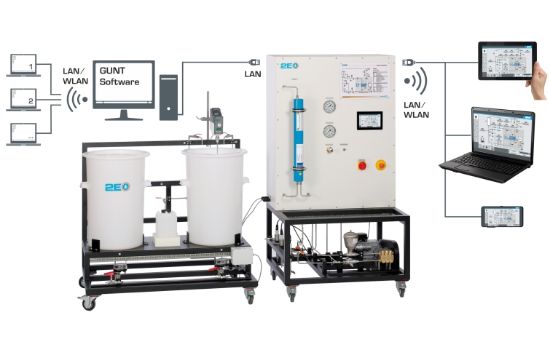This trainer has been developed in cooperation with the Institute for Thermal Process Engineering at the TU Hamburg-Harburg. A solution of NaCl in a defined concentration (up to 3,2% max.) is mixed in a tank complete with a stirring machine. A pump delivers the solution to the spiral wound membrane module. The pump generates the necessary pressure for separation.
The spiral wound membrane module consists of multiple membrane envelopes. A membrane envelope is made up of two membranes with a porous spacer between them. The membrane envelope is sealed on three sides and on its fourth, open, side is connected to the perforated permeate collecting tube. There are other spacers between the envelopes to ensure axial flow of the salt solution. The spacers together with the membrane envelopes are wound spirally around the permeate collecting tube. The salt solution arrives at the front face of the module and flows axially between the envelopes. The semi-permeable membrane is permeable to water (permeate) but not to dissolved NaCl. The applied pressure forces the water through the membrane into the envelopes. In the envelopes the water flows spirally towards the permeate collecting tube and exits the module in an axial direction. As a result of the water being removed, the solution is concentrated as it travels through the module. It exits the module as retentate and is returned to the raw water tank. The permeate is collected in a separate tank. In order to check the success of the separation, salt concentrations in the raw water, retentate and permeate are recorded by measuring the respective conductivity values.
The trainer is controlled by the PLC via touch screen. The pressure and flow rate can be adjusted by valves. By means of an integrated router, the trainer can alternatively be operated and controlled via an end device. The user interface can also be displayed on additional end devices (screen mirroring). Via the PLC, the measured values can be stored internally. Access to stored measured values is possible from end devices. Via direct LAN connection the measured values can also be transmitted to a PC where they can be analysed using the GUNT software.

Reverse osmosis
This trainer has been developed in cooperation with the Institute for Thermal Process Engineering at the TU Hamburg-Harburg. A solution of NaCl in a defined concentration (up to 3,2% max.) is mixed in a tank complete with a stirring machine. A pump delivers the solution to the spiral wound membrane module. The pump generates the necessary pressure for separation.
The spiral wound membrane module consists of multiple membrane envelopes. A membrane envelope is made up of two membranes with a porous spacer between them. The membrane envelope is sealed on three sides and on its fourth, open, side is connected to the perforated permeate collecting tube. There are other spacers between the envelopes to ensure axial flow of the salt solution. The spacers together with the membrane envelopes are wound spirally around the permeate collecting tube. The salt solution arrives at the front face of the module and flows axially between the envelopes. The semi-permeable membrane is permeable to water (permeate) but not to dissolved NaCl. The applied pressure forces the water through the membrane into the envelopes. In the envelopes the water flows spirally towards the permeate collecting tube and exits the module in an axial direction. As a result of the water being removed, the solution is concentrated as it travels through the module. It exits the module as retentate and is returned to the raw water tank. The permeate is collected in a separate tank. In order to check the success of the separation, salt concentrations in the raw water, retentate and permeate are recorded by measuring the respective conductivity values.
The trainer is controlled by the PLC via touch screen. The pressure and flow rate can be adjusted by valves. By means of an integrated router, the trainer can alternatively be operated and controlled via an end device. The user interface can also be displayed on additional end devices (screen mirroring). Via the PLC, the measured values can be stored internally. Access to stored measured values is possible from end devices. Via direct LAN connection the measured values can also be transmitted to a PC where they can be analysed using the GUNT software.
